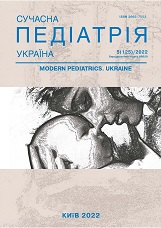Analysis of bacteriological diagnosis of complicated pneumonia in children and antibiotic resistance in isolated pathogens
DOI:
https://doi.org/10.15574/SP.2022.125.43Keywords:
children, complicated pneumonia, bacteriological diagnosis, antibiotic resistanceAbstract
Purpose - to analyze the results of bacteriological diagnosis of complicated pneumonia in children and antibiotic resistance in isolated pathogens.
Materials and methods. There were analyzed inpatient medical records (form 003/o) of 1,175 patients with complicated pneumonia at the age from 2 months to 18 years treated at the Ivano-Frankivsk Regional Children’s Clinical Hospital of the Ivano-Frankivsk Regional Council during 2012-2020. Due to the severity of illness, 827 (70.4%) children were hospitalized to the anesthesiology department and intensive care unit. Among patients with community-acquired pneumonia, there were 248 (29.9%) one-year-old children. The rest of children (n=348 - 29.6%) were diagnosed with nosocomial pneumonia, including ventilator-associated pneumonia in 103 (29.6%) children.
In most cases (n=1,092 - 92.9%), complicated pneumonia developed secondary to purulent endobronchitis. Purulent pulmonary and pulmonary pleural pathological processes were less common (n=83 - 7.1%). A total of 3,196 bacteriological studies were carried out, including studies of bronchial aspirate (n=2,695 - 84.3%), pleural effusion (n=175 - 5.5%), and blood culture for sterility (n=326 - 10.2%).
Bacteriological studies were carried out in accordance with the Order of the Ministry of Health of Ukraine No. 167 on Approval of the Methodological Guidelines «Determination of the Sensitivity of Microorganisms to Antibacterial Drugs» dated April 05, 2007.
Results. During bacteriological investigation of bronchial tree aspirate, the positive results were obtained in 773 (28.7%) cases, there were isolated 956 pathogens, including 183 (23.7%) cases had a mixed infection. Gram-negative bacterial pathogens prevailed: Pseudomonas aeruginosaе (n=383 - 48.1%), Klebsiella рneumoniae (n=140 - 17.6%) and Acinetobacter baumannii (n=104 - 13.0%).
Gram-negative bacteria isolated from blood cultures were characterized by high resistance to the following reserve antimicrobials: carbapenems (68.4%-52.9%), fourth-generation cephalosporins (cefepime - 65.6%), third-generation cephalosporins (52.5%-31.6%) and to a lesser extent, to cephalosporins/beta-lactamase inhibitors. There was an upward trend in the resistance of isolated pathogens to fluoroquinolones, penicillin / beta lactamase inhibitors.
Gram-positive bacterial pathogens demonstrating high resistance to almost all antibiotic groups accounted for 16.6%, with Staphylocоccus aureus (76.1%) being the most predominant pathogen.
Conclusions. Over the past eight years, a high frequency of infecting by gram-negative microorganisms among patients with complicated pneumonia has been observed and high antibiotic resistance of isolated pathogens, especially to reserve antimicrobials, has been proven. Pseudomonas aeruginasaе, Klebsiella pneumoniaе, Acinetobacter baumannii are dominant among gram-negative pathogens causing complicated pneumonia.
Gram-positive bacterial pathogens of complicated pneumonia accounted for 16.6%, with Staphylocоccus aureus being the most predominant bacterium, and demonstrated a fairly high antibiotic resistance.
Both the compliance with the indications, dosage and treatment regimens and consideration of antibiotic sensitivity of pathogens in every medical institution are the most important prerequisites for reducing antibiotic resistance, as well as slowing down the spread of antifungal resistance and preventing generalized mycosis.
The study was carried out in accordance with the principles of the Declaration of Helsinki. The study protocol was adopted by the Local Ethics Committee of the institutions specified in the work. The informed consent of the parents or guardians of the children was obtained for the study.
No conflict of interests was declared by the authors.
References
Abaturov AE, Kriuchko TA. (2017). Current and future etiologic therapy of bacterial pneumonia. 1. Antibiotic therapy for community-acquired pneumonia. Child's Health. 12 (3): 95-102. https://doi.org/10.22141/2224-0551.12.3.2017.104231
Abaturov AE, Kriuchko TA. (2018). Antibiofilm therapy in the treatment of respiratory infectious diseases caused by bacterial pathogens. Child's Health. 13 (7): 126-130.
Abaturov AE, Kriuchko TA. (2019). Inhibition of bacterial quorum sensing (general concept). Child's Health. 14 (1): 79-84.
Bielenechev IF, Horchakova NO, Bukhtiiarova NV et al. (2021). Pobichna diia likiv: pidruchnyk. Vinnytsia: Nova knyha: 360.
Bradley YS, Nelson JD, Barnett ED et al. (2019). Pediatriac antimicrobial Therapy. American Academy of Pediatric: 331.
Esakova NV, Pampura AN. (2020). Epidemiological aspects of drug-induced anaphylaxis in children. Pediatriya named after G.N. Speransky. 99 (2): 242-248.
https://doi.org/10.24110/0031-403X-2020-99-2-242-248
Kryvopustov SP. (2017). Suchasnyi dosvid antybiotykoterapii infektsii orhaniv dykhannia u ditei: u fokusi uvahy problema antybiotykorezystentnosti. Child's Health. 12 (8): 116-118.
MedExpert. (2018). Resolution First International Congress Antibiotic resistance STOP! (Kyiv, November 15-16, 2018). Perinatologiya i Pediatriya. 4: 12-13.
Tsymbalista OL. (2014). The microbic analysis of the bronchial tree and antibioticoresistance under complicated pneumonia among children. Perinatologiya i Pediatriya. 2: 54-57.
Tsymbalista OL. (2017). Problem of antibiotic resistance of microorganisms (lecture). Modern pediatrics. 2: 52-56. https://doi.org/10.15574/SP.2017.82.52
Tsymbalista OL. (2021). Dytiacha pulmonolohiia: navchalnyi posibnyk. Kyiv: Medytsyna: 624.
Vyhovska OV, Grechuha YeO, Tkachuk OI. (2017). Antibiotic susceptibility and antibiotic resistance according to the data of Kyiv Municipal Children's Clinical Infectious Diseases Hospital from 2012 to 2016. Actual Infectology. 5: 39-44. https://doi.org/10.22141/2312-413x.5.5.2017.121632
Yovenko IA, Balaka IV. (2017). Programma «Antimicrobial Stewardship» - strategiya antibakterialnogo kontrolya v OIT v Epokhu antibiotikorezistentnosti. Acute and emergency conditions in medical practice. 5-6: 5-14.
Zabolotnyi DI, Sambur MB, Voroshylova NM, Verevka SV. (2019). Extracellular components of biofilms in the formation of antibiotic resistance and chronicity of the inflammatory process. State of the problem. Otorhinolaryngology. 2-3: 72-84.
Downloads
Published
Issue
Section
License
Copyright (c) 2022 Modern pediatrics. Ukraine

This work is licensed under a Creative Commons Attribution-NonCommercial 4.0 International License.
The policy of the Journal “MODERN PEDIATRICS. UKRAINE” is compatible with the vast majority of funders' of open access and self-archiving policies. The journal provides immediate open access route being convinced that everyone – not only scientists - can benefit from research results, and publishes articles exclusively under open access distribution, with a Creative Commons Attribution-Noncommercial 4.0 international license (СС BY-NC).
Authors transfer the copyright to the Journal “MODERN PEDIATRICS. UKRAINE” when the manuscript is accepted for publication. Authors declare that this manuscript has not been published nor is under simultaneous consideration for publication elsewhere. After publication, the articles become freely available on-line to the public.
Readers have the right to use, distribute, and reproduce articles in any medium, provided the articles and the journal are properly cited.
The use of published materials for commercial purposes is strongly prohibited.

